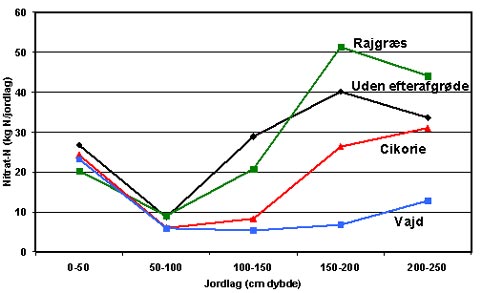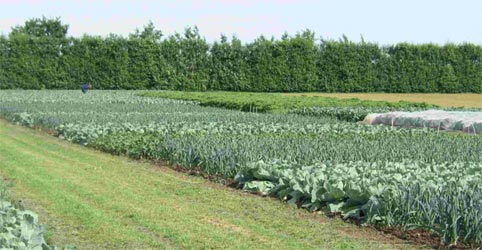Subproject 8
The importance of crops and catch crops with very deep roots in crop rotation, N cycling and modelling
Participants
Head of research unit Kristian Thorup-Kristensen, Ph.D. student Anders Pedersen and researcher Hanne L. Kristensen, Dept. of Horticulture, Danish Institute of Agricultural Sciences, Årslev.
Emails: Kristian.ThorupKristensen@agrsci.dk; Hanne.Kristensen@agrsci.dk; Anders.Pedersen@agrsci.dk
Background
When growing crops there is always a leaching loss of nitrate. The level of loss does, however, depend on the root depth of the crop. Nitrate can be regarded as lost when leached to just 0.5 m under shallow rooted crops, whereas other crops can take up and recycle nitrate from much deeper soil layers. Some crops like white cabbage and other crucifereous species with long growing seasons can use nitrate from more than 2 m depth. This nitrate is out of reach for most other crops. Despite this, it is still a relatively shallow rooted crop, ryegrass (0.75-1 m depth) undersown in a grain crop, that is the most commonly used catch crop (cover crop). To improve our knowledge on deep root growth and its use this project will 1) investigate deep root growth and its importance for N cycling in soil layers down to 2.5 m depth, 2) search for and test new deep rooted catch crops for undersowing in grain crops, and 3) improve counseling in catch crops by use of computer modelling.
Activities
In series of experiments we have investigated more than 20 species for their potential as catch crops undersown in a grain crop. This have included studies of root growth and effect on N supply for the following crop and comparison with the effects of a ryegrass catch crops.
In another series of experiments we have studied N cycling in different 3 year sequences of crop rotations where root depth varied strongly over time. In each of the 3 years we have included crops with shallow, intermediate and deep root growth in the crop rotations. In a number of combinations of these crops we have studied N uptake, root growth, and N dynamics to 2.5 m depth, to investigate the importance of deep root growth for N cycling.
Results
We found several species suitable for use as undersown catch crops of which many had deeper root growth than ryegrass. Only few did, however, show very deep root growth. The most promising was woad, which is a cruciferous species. Woad had the deepest root growth and was the species that depleted nitrate from deep soil layers most efficiently. The effect on N supply for the following crop of woad and other of the cruciferous species was significantly better compared to other non-legumeous species in the experimental series.
The studies of N dynamics in sequences of crop rotations showed that nitrate was quickly leached to deeper soil layers, but also that a substantial amount of this nitrate was taken up again by a number of crops. A comparison was made for example between leek, beetroot and white cabbage which had root depths of approx. 0.5, 1.7 and more than 2.5 m. Eventhough both beetroot and white cabbage showed deep root growth there was a big difference on their ability for deep N uptake, and beetroot left up to 100 kg N/ha more than white cabbage in the subsoil. The results illustrate very convincingly the advantage of growing catch crops before crops with a shallow root system.
By use of computer modelling we are going to use knowledge on soil types and precipitation, as well as on root growth of catch crops and main crops to simulate when and how it is most advantageous to grow catch crops.
Figure 1
Nitrate-N left in the soil per hectar in November 2002 under different catch crops undersown in barley in spring. Ryegrass depleted a bit more that the uppermost 0.5 m, whereas the two other catch crops were far more efficient below this depth. Especially woad was efficient in N depletion down to 2.5 m depth.

Figure 2
The experiment showing the importance of crops with very different root depths and N use from deep soil layers. The three crops shown had root depths from 0.5 m (leek) to more than 1.5 m (beetroot) and 2.5 m depth (white cabbage).

Scientific publications
Kristensen, H. L. and Thorup-Kristensen, K. (2004) Root growth and nitrate uptake of three different catch crops in deep soil layers. Soil Science Society of America Journal 68: 529-537.
Thorup-Kristensen, K., J. Magid, and L.S. Jensen. 2003. Catch crops and green manures as biological tools in nitrogen management in temperate zones. Adv. Agron. 79:227-302.
Kristensen, H.L. and Thorup-Kristensen, K. (2002) Root depth and nitrogen uptake from deep soil layers in organic vegetable production – a preliminary study. Acta Horticulturae 571: 203-208.
Danish publications
Kristensen, H. L. and Thorup-Kristensen, K. (2002). Efterafgrøder og grønsager kan udnytte kvælstof ned til 2,5 meters dybde. Poster ved Økologi-Kongres 2002. Odense Congress Center 20.-21. nov. 2002.
Kristensen, H.L. og Thorup-Kristensen, K. (2003) Efterafgrøder kan optage "tabt" nitrat fra stor dybde. Månedsmagasinet Mark 7: 14-15.
|